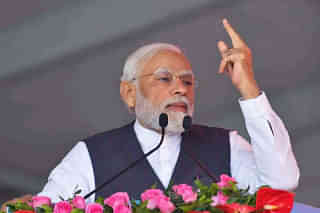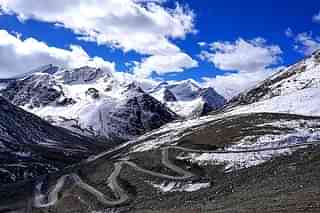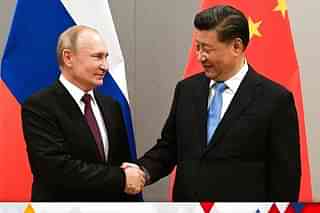Commentary
Andhra Politics: CBN & YSR Jugalbandi
Krishnarjun
Sep 09, 2011, 06:36 PM | Updated Apr 29, 2016, 02:55 PM IST
Save & read from anywhere!
Bookmark stories for easy access on any device or the Swarajya app.

Chandrababu Naidu (CBN) & Rajasekhar Reddy(YSR) got elected to the state assembly for the first time in the year 1978. Its generally known in political circles that they used to be close friends during days when they were emerging young leaders in the AP Congress. Incidentally both became ministers in the same term and later went on to lord over the destiny of Andhra Pradesh as CM and opposition leader for the major part of last two decades. Let’s examine how they altered the AP political landscape.
Chandrababu Naidu Regime (1995-2004)
Born in a middle class farmer family, the political journey of CBN gained momentum after getting elected on Congress ticket in 1978. He served as a cinematography minister in Cong govt. During this ministerial stint, he came close to NTR and married his daughter. CBN refused to join and even ridiculed NTR’s new party initially but did join it later after NTR captured power. Political opportunism has consistently marked his brand of politics right from the beginning. His lack of charisma and less than modest communication skills prompted him to rely more on back room Machiavellian maneuvering and political management based on a ruthless political instincts. Often it was alleged by party insiders that CBN patronized the corrupt elements in relatively corruption-free NTR dispensation. Even as he earned the trust of his legendary father-in-law, TDP insiders suggest that scheming CBN was plotting and patiently waiting to succeed NTR at an opportune moment. The opportunity came when widower NTR remarried Lakshmi Parvathi, a researcher who was chronicling hs life.
After NTR won historic mandate in 1994 securing close to 260 seats along with left parties, CBN with the help of media baron Ramoji Rao’s Eenadu was successful in creating an impression that Lakshmi Parvathi, will take over TDP by doing a Jayalalitha encore in Andhra Pradesh. This disinformation campaign critics allege was done by planting inspired stories in newspapers and internal party publications. By this time CBN had established complete stranglehold over the party machinery. In a successful coup, helped by then Governor Krishna Kanth and possibly with tacit support from P.V Narasimha Rao, he dislodged NTR from his own party and Government in a stunning palace coup.
CBN always lacked charisma of NTR and going by the verdict of parliamentary elections in 1996 & 1998 voters at large didn’t warm up to him. Realizing that he cannot position himself as a populist leader in NTR mould, he orchestrated a high-tech image makeover exercise aided and abetted by a media that tended to largely friendly to him. He followed a model of highly centralized leadership on the lines of communist party. Many times he went on record suggesting that Jyothi Basu was his role model and he desired to follow the CPM leader’s Stalinist footsteps. He dreamt of ruling Andhra till the end of his life.
Credit needs to be given where its due. CBN introduced massive changes in administration and with the help of computerization made govt more responsive to citizens. He devised programmes like “Janma bhoomi”, “Sramadhanam” to win over citizens in the name of public participation. It was suggested by critics and sometimes justifiably so that he relied more on propaganda than conviction in implementing these initiatives. Despite general goodwill generated by an impression of running an energetic administrtion, CBN led TDP didnt gain huge electoral traction In 1998 parliament elections for the first time saw the spectacular rise of BJP in AP as it secured 20 percent of votes and won four seats on its own. BJP’S performance was particularly impressive in Telangana. Sensing ground slipping beneath his feet CBN supported 13 month Vajpayee govt and went for an alliance with BJP in 1999 assembly and parliament elections and returned back to power again. This is not to say that because of BJP he won but BJP did play a crucial role in his victory.
When analysing his policies while in power, it can be said that CBN focused heavily on Hyderabad and IT while neglecting rest of the state and other sectors of development. In his 9-year rule he failed to add any substantial irrigation infrastructure in a state largely dependent on agriculture. He obtained a massive 20,000 crs loans from World Bank but largely squandered them on non productive programs and infrastructure. While rural Andhra was reeling under successive droughts he was out of touch with reality and relied on propaganda targeting upper middle class which did got benefitted from his IT centric policies. It was whispered that at highest level of government wheeling dealing continued unabated but CBN sought to don the mantle of anti-corruption crusader by coming down heavily on lower level of government machinery. He tried to influence public opinion in his favor by televised dressing down of lower bureaucracy and making a spectacle out of it. All these costed him heavily in 2004 elections. His two pronged plans to beat the palpable anti-incumbency by invoking the sympathy following an failed assassination attempt on him by naxals and leveraging tremendous groundswell of public support that Vajpayee enjoyed failed speactacularly . Towards the end of his innings his track record and style of functioning gave an impression to large sections of population that he is opportunistic and highly self centered individual who can’t trust anyone. YSR has highlighted this aspect of CBN and using other weaknesses of his regime, successfully dislodged CBN from power and from his self assumed high CEO pedestal in 2004.
Y. S. Rajasekhar Reddy regime
Born in a family with factionist background and mining interests in Rayalseema badlands, YSR completed his medicine studies and practiced for a short period. He plunged into politics and won his first election from Pulivendula on Brahmananda Reddy’s congress(R) ticket in 1978. He served as minister during that term but never became minister again till he became CM in 2004. He was a perpetual rebel and disgruntled person althrough his career in state Congress politics until the raise of holy mother Sonia. He actively encouraged and fomented dissidence against successive incumbents. Congress CM’s between 1989-94 Chenna Reddy, with sufficient evidence, accused him of engineering communal riots that rocked Hyderabad between 1990-93. He owes his enormous money and brutal muscle power to his father Raja Reddy who was a dreaded factionist in the Kadapa region of Rayalseema. But, the real game changer in his career came when he convinced Rajiv Gandhi to appoint him as PCC chief at the age of 32, after NTR’s stellar performance in 80’s. It gave him an opportunity to extend his political influence beyond Kadapa and he brilliantly succeeded in doing that. From that time he maintained his own loyal faction within Congress with supporters across the state. With Kamma-Kapu divide in delta districts of Andhra and minimal Reddy presence in the region he consciously wooed sections of Kapu leadership. Courtesy his religious background he could associate closely with converted Christian groups in coastal Andhra. In Rayalaseema and Telangana he became rallying point for Reddy politics once he took over as PCC chief for the second time in 1999. All this effort spanning 30 years paid him rich dividends in defeating CBN and in consolidating power thereafter.
YSR was a natural politician who rose from the ranks within Congress. However skepticism about him always prevailed given his faction background and TDP used to highlight this at every available occasion. Not many political analysts regarded him as CM contender until he executed a masterstroke by undertaking 1400kms walk across the state braving blistering heat. This was a turning point in his political career as it brought him closer to masses and also first hand understand the agrarian distress in rural AP. This penance turned him into a mass leader and in a sense changed perpetually disgruntled rebel leader into a matured politician.
After assuming power master politician in YSR started his work. With his padayatra experience he acquired firsthand knowledge on real issues. He focused on enhancing irrigation infrastructure in a state with two major rivers. He did achieve a right understanding of the issues confronting the masses but state welfarism based interventions that he designed always sought to promote corruption and nepotism. He tried to factionalize entire state with his carrot and stick policy symptomatic of his political schooling in Rayalseema. He identified TDP support base of OBC’s and aggressively wooed them, while isolating Kammas wherever possible. He took care of his own constituency comprising of upper castes minus Kammas, Christians,Muslims and Dalits. With a booming economy to support reckless spending, he doled out welfare schemes targetting lower middle class and weaker sections.
On the other hand he allowed rampant corruption at all levels. He even auctioned govt land to fund these schemes that were started in the final year of his tenure. His 108 emergency medical service and arogyasri were novel ideas and continue to remain very popular. He branded sections of press writing against his corruption as casteist and attempted to intimidate them by using strong-arm tactics but failed. The two news papers Eenadu and Andhra Jyothy faced the challenge with courage and assumed the role of opposition while CBN utterly failed as opposition leader. Ramoji Rao didn’t budge even at the prospect of his business empire that he meticulously built over the years imploding and he deserves kudos for maintaining the integrity of fourth estate. YSR tried to muzzle all kinds of opposition.
YSR clandestinely encouraged conversions with a long term goal of demographic changes. His son-in-law brother Anil Kumar was sperheading the rapid evangelisation of Andhra and even attempted to eliminate rival evangelical groups lead by people like K.A.Paul. Paul became bitter critic of YSR. While he increased salaries for pujaris he auctioned temple lands to fill exchequer. He blatantly indulged in communal engineering by establishing Christian economic commission and funded Bethlehem yatras with public money. He initiated reservations for Muslims and his antics on tirumala temple were well documented. In five years of his term he attempted far reaching changes in Andhra polity and society. However, inspite of all these he could win only 35% percent of popular vote and thread bare majority in assembly 156/290, while congress won 33/42 MP seats even after massive voter turnout. The corruption exposes by media did struck chord with a section of population and the Mahakutami formed with TDP-TRS did damage YSR at assembly level while PRP floated by chranjeevi helped YSR in some regions and damaged him in other regions.
After assuming office for the second time YSR did realized that his adventures were not received well by sections of population and attempted a moderate approach before he met with accident that took his life. There are questions raised about this accident and some of them are valid given his aggressive nature, alleged confrontation with Ambanis on K.G basin and his attempt to establish himself as leader in his own right.
To summarize Andhra Pradesh is at cross roads after sixteen years of misrule by CBN and YSR. Apart from some development in IT there is not much progress in other areas like manufacturing, etc despite immense potential and long history of a resident entrepreneurial class. Rural economy is crumbling with unprofitable agriculture and farmers in delta districts of Godavari have decided to go on a crop holiday. Hyderabad has lost it’s sheen because of Telangana agitation and there is no development in coastal Andhra cities like Vijayawada. Congress rule has proved catastrophic for state with complete breakdown of government machinery and unlike the neighboring Karnataka, which despite its strings of scams has managed to sustain its growth. A strong decisive leadership is the need of hour, but no many options are in the horizon at this confusing period of Andhra history.
If not handled properly, Andhra may witness complete caste polarization with bitter fight between different groups for political domination akin to bihar of yesteryears.
Krishnarjun is a friend of CRI. He tweets as krishnarjun108
Save & read from anywhere!
Bookmark stories for easy access on any device or the Swarajya app.
Support Swarajya's 50 Ground Reports Project & Sponsor A Story
Every general election Swarajya does a 50 ground reports project.
Aimed only at serious readers and those who appreciate the nuances of political undercurrents, the project provides a sense of India's electoral landscape. As you know, these reports are produced after considerable investment of travel, time and effort on the ground.
This time too we've kicked off the project in style and have covered over 30 constituencies already. If you're someone who appreciates such work and have enjoyed our coverage please consider sponsoring a ground report for just Rs 2999 to Rs 19,999 - it goes a long way in helping us produce more quality reportage.
You can also back this project by becoming a subscriber for as little as Rs 999 - so do click on this links and choose a plan that suits you and back us.
Click below to contribute.





